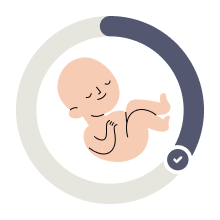Once you reach 33 weeks of pregnancy, your baby will be entering the “finishing period.“
During this time, your baby’s development will be rapidly progressing, and it’s important to understand what to expect. Additionally, you may want to start thinking about developing a parenting plan and purchasing baby clothes to prepare for your little one’s arrival.
As you approach week 33 of your pregnancy, it’s a good idea to begin packing your hospital bag and Preparing for postpartum care. Stocking up on essential new mom care supplies and familiarizing yourself with postpartum care can help you feel more prepared for the arrival of your baby.
While it’s possible that your baby won’t arrive for another month or so, it’s better to be prepared in case of an early surprise arrival.
Pregnancy Week 33 Quick Facts
- At 33 weeks, you’re eight months 1 week pregnant.
- You have 7 weeks until your due time “Calculate Your Due Date”
- This is your third trimester
Your Unborn Baby’s Size at 33 Weeks
How Big is a Baby?
Your baby weighs approximately 1919 grams and is the size of a pineapple. While developing, your baby was covered in fine hair called lanugo, which helped keep them warm. However, at this stage, it’s starting to disappear, although there may still be patches of it on their shoulders and back. Your baby’s length is 43.7 centimeters.
Pregnancy Symptoms Week 33
What position is the baby in at 33 Weeks?
As you approach the end of your pregnancy, your baby is likely in a head-down position or will be soon at 33 weeks. Your 33-week fetus is also moving towards your pelvis, which may cause your belly to feel lower, as if it has “dropped”. However, some babies may not move into this position until the very end of pregnancy, so if you don’t notice any changes yet, there’s no need to worry.
Breast Nipple color changes
As you approach the later stages of pregnancy, you may experience some new symptoms, including darker nipples. Hormonal changes can cause your areolas to look different, possibly as an evolutionary adaptation to help your baby find them more easily during breastfeeding.
Are you feeling uncomfortable in your current bra? Do you feel like you need to purchase a bigger size again?
In addition, you may notice that your breasts have increased in size and started producing colostrum, a thick and highly beneficial yellow fluid that your baby will consume during the first few days of life. While it’s still too early for your baby to arrive, it’s important to watch for signs of preterm labor. At this stage, your baby weighs approximately 4 pounds.
Are you suddenly feeling an intense urge to clean and organize your house or baby’s nursery?
This is known as nesting, a common impulse that arises in the final weeks of pregnancy as you prepare for your new arrival. However, one thing that may hinder your nesting instincts is the lack of sleep, which is a typical third-trimester symptom. Many factors can contribute to this, including a full bladder or an active baby. It’s crucial to take care of yourself and rest whenever possible!
Prenatal Tests and Doctor’s Appointments
When you reach 33 weeks of pregnancy, you are considered to be eight months pregnant, although doctors typically track your pregnancy progress by week rather than month.
If you were to have an ultrasound at 33 weeks pregnant, you would likely see that your baby is keeping their eyes open while awake. This type of ultrasound, called a biophysical profile (BPP), is typically done in the third trimester for high-risk patients or for women who go past their due dates. During the ultrasound, your healthcare provider will assess your 33-week fetus’s movement, breathing, muscle tone, and the amount of amniotic fluid present.
The other part of the BPP, the non-stress test, will measure how your baby’s heart rate changes when they move or when you have contractions. This ultrasound is an opportunity to confirm that everything is progressing well with your 33-week baby, and may provide some peace of mind during this exciting but sometimes stressful time.
If you’re currently on an every-other-week schedule for check-ups, you may have your next appointment at your provider’s office next week when you’re 34 weeks along.
Between weeks 27 and 36, your provider may offer you the whooping cough vaccine, which is recommended by the CDC.
Typically, a screening test for group B strep (also known as GBS or beta strep) will be done between weeks 36 and 38.
Special Considerations
Preeclampsia is a pregnancy-related condition that can have serious consequences and effects blood pressure, as well as various organs in the body such as the kidneys, liver, and central nervous system. It is estimated that between 2% to 8% of pregnant individuals develop preeclampsia. Healthcare providers screen for preeclampsia at every prenatal appointment.
- Prepare for postpartum recovery by gathering necessary items
- Focus on maintaining good posture
- Regularly stretch your body and muscles
- Practice Kegel exercises to strengthen your pelvic floor muscles.
Postpartum Preparation
Presently, much attention is directed towards your approaching labor and delivery, as well as tending to your newborn. However, it’s crucial to keep in mind that you’ll also require self-care after childbirth. This entails planning for your recovery period and collecting postpartum essentials.
- If you have a vaginal delivery, the following items can help facilitate your recuperation:
- A pain-relieving spray can be applied after using the bathroom or changing a pad to numb the vaginal area.
- Using a doughnut-shaped cushion can alleviate pressure on the sensitive area between the vagina and rectum (perineum) while sitting.
- A peri bottle filled with lukewarm water can provide relief by indirectly spraying the vaginal area while urinating, soothing the delicate tissue and reducing stinging.
- A sits bath, a shallow basin placed on top of the toilet, filled with warm water can ease pain and promote healing.
- For those with hemorrhoids or other postpartum issues, having a gentle stool softener recommended by a healthcare provider can help make the first bowel movement after delivery less intimidating.
These items can be incredibly helpful after giving birth, regardless of your delivery method:
1. Comfortable clothing
- Make sure you have some comfortable lounge pants to wear at home after the birth. If you have a C-section, you may prefer pants with a loose-fitting or adjustable waist.
2. Maxi pads
- Whether you give birth vaginally or via C-section, you’ll experience postpartum vaginal bleeding for up to six weeks. Heavy-flow maxi pads can be useful, and you can even use them to create soothing ice packs by adding aloe vera gel and witch hazel.
3. Ibuprofen
- This over-the-counter medication can help with perineal pain, cramping, and post-birth bleeding. Talk to your healthcare provider about the best dosing schedule for you.
4. Nipple cream
- Applying modified lanolin ointment or expressed breastmilk after nursing can help prevent and heal sore nipples.
5.Nursing pads
- These pads come in disposable and reusable options and can absorb any breast milk leaks and protect sore nipples from rubbing.
6. Nursing or pumping bra
- These bras make it easier to breastfeed or pump hands-free, depending on your needs.
Developmental Milestones
Baby develops coordination of breathing, sucking, and swallowing at 33 weeks. Additionally, your fetus’s bones are hardening, and significant brain development is occurring, making for one smart baby!
Around week 28, your baby’s sucking reflex might have been weak, but now they’re starting to coordinate and practice sucking and swallowing. Baby can demonstrate rooting reflex by turning head and opening mouth.
At 33 weeks along, experiencing actual contractions would be considered preterm labor since it’s still early in the pregnancy. However, certain conditions and complications, like having too much amniotic fluid or carrying twins, can increase the likelihood of going into labor early.
Survival Outside the Womb
Babies born moderately preterm at 33 weeks still require some maturing before they’re ready to go home. Special care will be necessary for babies born around this time. While there’s still a risk of disabilities resulting from prematurity, the survival rate for babies born at 33 weeks is 99%.





